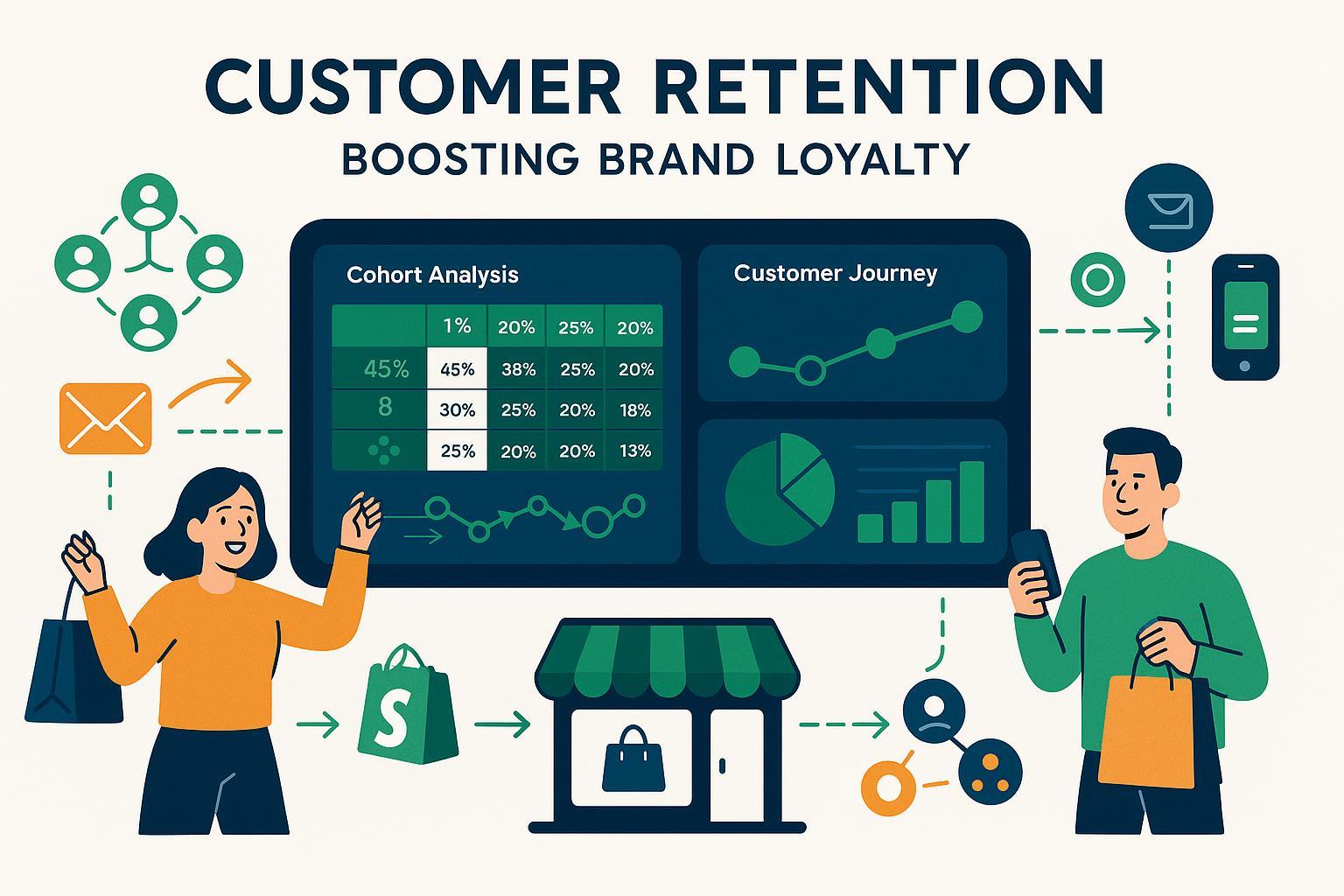The Role of the Customer Retention Department in Enhancing Brand Loyalty: Best Practices for E-commerce

Introduction: Why Retention is the Engine of Brand Loyalty
For e-commerce brands, acquiring new customers is increasingly expensive—while maximizing the value of every existing customer can be transformational for sustainable growth. According to Shopify, repeat customers contribute over 28% of e-commerce revenue on average, and brands with above-average retention systematically outperform those relying on first-time sales Shopify retention data. Advanced retention teams are now using analytics, multi-touch attribution, and automated engagement flows to not only keep customers coming back but to actively build lifelong loyalty and advocacy.
What Is the Customer Retention Department?
The Customer Retention Department is a strategic, cross-functional unit, focused on designing and executing programs that encourage repeat purchases, foster emotional connection, and maximize customer lifetime value. Its responsibilities extend from journey mapping to segmentation, incentive planning, campaign execution, and rigorous ROI measurement. Modern retention teams leverage automation, analytics platforms, and integration with marketing attribution solutions—such as Attribuly—to transform retention from a reactive support function into a proactive loyalty engine.
Key Functions:
- Mapping post-purchase journeys and identifying friction or opportunity points
- Segmentation and targeting based on recency, frequency, and monetary (RFM) analytics
- Orchestrating retention campaigns through email, SMS, and dynamic site experiences
- Aligning brand experience (BX) and customer experience (CX) for consistent loyalty uplift
- Measuring incremental ROI from retention actions using attribution and analytics
Best Practices Framework for Retention Teams
1. Map and Analyze the Customer Journey
Successful retention departments start by mapping every step of the customer’s path—pre- and post-purchase—to diagnose pain points, moments of delight, and gaps in the brand experience. According to Forrester, journey analytics reveal up to 3.5x revenue growth when BX and CX are aligned (Forrester BX Index).
Best practice: Implement journey mapping platforms that integrate with Shopify and major ad channels, such as Attribuly, to track each customer’s touchpoints, purchases, and interactions. This feeds into smarter segmentation and more empathetic engagement flows.
2. Deep-Dive Segmentation: RFM, Cohort, and Behavioral Analytics
Generic lists don’t drive loyalty—precision does. Retention pros use advanced segmentation frameworks, with Recency, Frequency, Monetary (RFM) modeling and cohort analysis to group customers by value, journey stage, and behavior (Klaviyo Retention Strategies).
Best practice: Create targeted segments for VIP customers, at-risk churners, and new buyers. Use behavioral triggers (e.g., site browse abandonment) and cohort-based flows to deliver highly personalized offers, earning repeat business and brand trust. Automated tools like Attribuly and Klaviyo enable RFM segmentation, identity resolution, and triggered campaigns based on cross-channel data.
3. Multi-Touch Attribution: Measuring the True ROI of Retention
How do you know which retention activities actually move the needle? Multi-touch attribution models are essential for tracing revenue uplift back to specific campaigns, incentives, and customer journeys. Attribution platforms like Attribuly give retention managers real-time insight into which touchpoints—from post-purchase emails to loyalty incentives—directly impact repeat revenue.
Best practice: Set up multi-touch attribution and server-side tracking to monitor retention program ROI and optimize budget to high-impact channels. Benchmark results against industry retention rates (26–31.5% per Shopify) and use daily dashboard reports for ongoing improvement.
4. Automated Retention Campaigns: Personalization at Scale
Retention is won by delivering value—at the right moment. Automation platforms enable triggered, segment-based communications that nurture relationships and recover at-risk customers. For example, Klaviyo and Attribuly allow retention teams to deploy targeted flows for win-back, review requests, and loyalty rewards, measuring engagement and conversion by segment.
Best practice: Deploy automated win-back, review, and loyalty reward flows across channels. Use incentive triggers (e.g., photo submission rewards, purchase anniversaries) to drive advocacy and repeat sales. According to Klaviyo, targeted cancellation flows can yield up to 71% repeat revenue (Grind Coffee Case Study).
5. BX/CX Alignment for Measurable Loyalty Uplift
Aligning Brand Experience (BX) and Customer Experience (CX) creates a unified, trustworthy journey, increasing both emotional loyalty and transactional retention. Forrester’s BX Index demonstrates brands that align BX/CX achieve lifetime value multipliers and far higher loyalty metrics (Forrester BX Index).
Best practice: Use diagnostic surveys, NPS, and experience dashboards, integrated into retention analytics tools, to identify gaps and systematically improve. Personalized content, value support resources, and transparent communications drive measurable uplift.
Case Studies and Comparative Table: Leading Retention Tools for E-commerce
| Tool | Key Features | Use Cases | Authority Level | Unique Value |
|---|---|---|---|---|
| Attribuly | Multi-touch attribution, segmentation, journey analytics; Shopify integration, server-side tracking | Retention ROI measurement, segmentation, campaign automation | Industry featured, MarTech.org | Unified view of retention touchpoints and incremental ROI |
| Klaviyo | Advanced email/SMS automation, cohort analysis, RFM segmentation | Automated retention flows, loyalty rewards, campaign orchestration | Case study-validated, market leader | Powerful segmentation and triggered loyalty programs |
| Peel Insights | Cohort dashboarding, daily metrics, Shopify app | Retention rate tracking, cohort benchmarks, dashboard reports | High app ratings, used by e-commerce retention teams | Fast cohort analysis and reporting |
| LoyaltyLion | Tiered rewards programs, automation | Structured loyalty tiers, advocacy triggers | Recommended by Klaviyo | Instant reward structures for boosting repeat purchase |
| Recharge | Automated subscription retention, churn reduction | Subscription analytics, retention triggers | Leading subscription brands | Personalized churn prevention and re-engagement automation |
Measurement & Reporting: KPIs, Dashboards, and Cohort Tracking
Retention departments must go beyond basic metrics. Key KPIs include repeat purchase rate, churn rate, cohort revenue, lifetime value (LTV), and incremental ROI from loyalty programs. Advanced tools allow daily dashboarding and cohort segmentation. Attribuly offers integrated dashboards for journey mapping, segment performance, and ROI tracking.
Pro Tip: Download our Retention Department KPI & Workflow Checklist to audit and improve your core metrics and process steps.
Strategic Integration: Building the Analytics-to-Action Workflow
Brand loyalty requires seamless collaboration between analytics, campaign automation, and experience design. Modern retention departments use a strategic workflow:
- Map customer journeys and segment audiences with RFM/cohort analytics (Attribuly, Peel)
- Automate retention flows for high-value segments (Klaviyo, Attribuly)
- Measure incremental ROI with attribution dashboards (Attribuly)
- Optimize BX/CX via feedback and journey gap analysis (Forrester tools)
- Report results daily/weekly to leadership with actionable dashboards
Conclusion & CTA
The modern Customer Retention Department is the cornerstone of e-commerce loyalty, driving measurable revenue through analytics-powered segmentation, attribution, and automation. By adopting the practices and frameworks above—and leveraging tools like Attribuly for deep journey analytics and ROI clarity—retention teams not only outperform competitors, but build brands customers love for life.
Ready to scale your retention program? Explore Attribuly’s retention analytics and attribution platform for e-commerce and download our actionable resources and playbooks to transform your brand’s loyalty outcomes.
References & Further Reading
- Forrester BX Index
- Klaviyo Retention Strategies
- Shopify Customer Retention Benchmarks
- Attribuly Customer Journey Mapping Guide
- Peel Insights App
